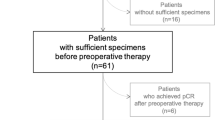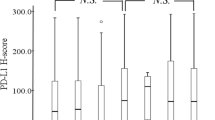Abstract
Introduction
Poliovirus receptor (PVR) is a tumor promoter and a regulatory checkpoint that enhances immunosuppression. We investigated PVR expression by applying immunohistochemistry (IHC) staining. A positive association existed between PVR expression and cytotoxic T lymphocyte-associated antigen 4 (CTLA4) expression in patients with surgically resected non-small-cell lung cancer (NSCLC). PVR expression is a prognosis predictor of lung adenocarcinoma.
Purpose
To investigate the prognostic significance of PVR expression and CTLA4 expression for surgically resected NSCLC.
Patients and methods
The medical records of 108 Chinese patients with primary NSCLC who underwent surgery were retrospectively reviewed. The expression of PVR and CTLA4 were measured through IHC. Clinical characteristics, the association between PVR and CTLA4, and the prognostic significance of PVR were analyzed.
Results
A significant positive association was observed between PVR and CTLA4 expression in NSCLC (P = 0.016). PVR had a high positive rate among females, nonsmokers, and patients with adenocarcinoma and advanced lung cancer. The overall survival (OS) of patients with negative PVR expression was significantly longer than that of patients with positive PVR expression (P = 0.049), especially among females (P = 0.03) and nonsmokers (P = 0.025). Multivariate analysis results showed that advanced tumor stage and PVR expression were independent prognosis predictors of poor OS.
Conclusion
PVR can potentially serve as a prognostic predictor and biomarker for NSCLC and cancer anti-CTLA4 immunotherapy response.




Similar content being viewed by others
References
Ardolino M, Zingoni A, Cerboni C, Cecere F, Soriani A, Iannitto ML, Santoni AJB (2011) DNAM-1 ligand expression on Ag-stimulated T lymphocytes is mediated by ROS-dependent activation of DNA-damage response: relevance for NK–T cell interaction. Blood 117:4778–4786
Brlić PK, Roviš TL, Cinamon G, Tsukerman P, Mandelboim O, Jonjić SJC (2019) Targeting PVR (CD155) and its receptors in anti-tumor therapy. Cell Mol Immunol 16:40–52
Chae YK, Arya A, Iams W, Cruz MR, Chandra S, Choi J, Giles F (2018) Current landscape and future of dual anti-CTLA4 and PD-1/PD-L1 blockade immunotherapy in cancer; lessons learned from clinical trials with melanoma and non-small cell lung cancer (NSCLC). J Immunother Cancer 6:39
Chan CJ et al (2014) The receptors CD96 and CD226 oppose each other in the regulation of natural killer cell functions. Nat Immunol 15:431
Dess RT et al (2017) Cardiac events after radiation therapy: combined analysis of prospective multicenter trials for locally advanced non-small-cell lung cancer. J Clin Oncol 35:1395–1402
Dickhoff C et al (2016) Population-based patterns of surgical care for stage IIIA NSCLC in the Netherlands between 2010 and 2013. J Thorac Oncol 11:566–572
Egen JG, Allison JPJI (2002) Cytotoxic T lymphocyte antigen-4 accumulation in the immunological synapse is regulated by TCR signal strength. Immunity 16:23–35
Fujito T et al (2005) Inhibition of cell movement and proliferation by cell-cell contact-induced interaction of Necl-5 with nectin-3. J Cell Biol 171:165–173
Gao X, McDermott DF (2018) Ipilimumab in combination with nivolumab for the treatment of renal cell carcinoma. Expert Opin Biol Ther 18:947–957
Gettinger S et al (2017) Impaired HLA class I antigen processing and presentation as a mechanism of acquired resistance to immune checkpoint inhibitors in lung cancer. Cancer Discov 7:1420–1435
Gridelli C et al (2015) Non-small-cell lung cancer. Nat Rev Dis Primers 1:15009
He W et al (2017) CD155T/TIGIT signaling regulates CD8(+) T-cell metabolism and promotes tumor progression in human gastric cancer. Cancer Res 77:6375–6388
Herzberg B, Campo MJ, Gainor JF (2017) Immune checkpoint inhibitors in non-small cell lung cancer. Oncologist 22:81–88
Hirsch FR, Scagliotti GV, Mulshine JL, Kwon R, Curran WJ Jr, Wu YL, Paz-Ares L (2017) Lung cancer: current therapies and new targeted treatments. Lancet 389:299–311
Huang DW, Huang M, Lin XS, Huang Q (2017) CD155 expression and its correlation with clinicopathologic characteristics, angiogenesis, and prognosis in human cholangiocarcinoma. Onco Targets Ther 10:3817–3825
Iguchi-Manaka A et al (2016) Increased soluble CD155 in the serum of cancer patients. PLoS ONE 11:e0152982
Iguchi-Manaka A et al (2020) High expression of soluble CD155 in estrogen receptor-negative breast cancer. Breast Cancer 27:92–99
Kakunaga S et al (2004) Enhancement of serum-and platelet-derived growth factor-induced cell proliferation by Necl-5/Tage4/poliovirus receptor/CD155 through the Ras-Raf-MEK-ERK signaling. J Biol Chem 279:36419–36425
Koike S et al (1990) The poliovirus receptor protein is produced both as membrane-bound and secreted forms. EMBO J 9:3217–3224
Le Pechoux C et al (2007) Need for a new trial to evaluate adjuvant postoperative radiotherapy in non-small-cell lung cancer patients with N2 mediastinal involvement. J Clin Oncol 25:e10–11
Li XY et al (2018) CD155 loss enhances tumor suppression via combined host and tumor-intrinsic mechanisms. J Clin Investig 128:2613–2625
Mahnke K, Enk AH (2016) TIGIT-CD155 interactions in melanoma: a novel co-inhibitory pathway with potential for clinical intervention. J Investig Dermatol 136:9–11
Mendelsohn CL, Wimmer E, Racaniello VR (1989) Cellular receptor for poliovirus: molecular cloning, nucleotide sequence, and expression of a new member of the immunoglobulin superfamily. Cell 56:855–865
Meng X, Liu Y, Zhang J, Teng F, Xing L, Yu J (2017) PD-1/PD-L1 checkpoint blockades in non-small cell lung cancer: new development and challenges. Cancer Lett 405:29–37
Nakai R et al (2010) Overexpression of Necl-5 correlates with unfavorable prognosis in patients with lung adenocarcinoma. Cancer Sci 101:1326–1330
Nishiwada S et al (2015) Clinical significance of CD155 expression in human pancreatic cancer. Anticancer Res 35:2287–2297
Noh JM et al (2015) Definitive bimodality concurrent chemoradiotherapy in patients with inoperable N2-positive stage IIIA non-small cell lung cancer. Cancer Res Treat 47:645–652
Pardoll DM (2012) The blockade of immune checkpoints in cancer immunotherapy. Nat Rev Cancer 12:252–264
Parra K et al (2017) Impact of CTLA-4 blockade in conjunction with metronomic chemotherapy on preclinical breast cancer growth. Br J Cancer 116:324–334
Parry RV et al (2005) CTLA-4 and PD-1 receptors inhibit T-cell activation by distinct mechanisms. Mol Cell Biol 25:9543–9553
Pitt JM et al (2016) Resistance mechanisms to immune-checkpoint blockade in cancer: tumor-intrinsic and-extrinsic factors. Immunity 44:1255–1269
Sloan KE et al (2004) CD155/PVR plays a key role in cell motility during tumor cell invasion and migration. BMC Cancer 4:73
Sloan KE, Stewart JK, Treloar AF, Matthews RT, Jay DG (2005) CD155/PVR enhances glioma cell dispersal by regulating adhesion signaling and focal adhesion dynamics. Cancer Res 65:10930–10937
Snyder A et al (2014) Genetic basis for clinical response to CTLA-4 blockade in melanoma. N Engl J Med 371:2189–2199
Takai Y, Miyoshi J, Ikeda W, Ogita H (2008) Nectins and nectin-like molecules: roles in contact inhibition of cell movement and proliferation. Nat Rev Mol Cell Biol 9:603–615
Tandberg DJ, Tong BC, Ackerson BG, Kelsey CR (2018) Surgery versus stereotactic body radiation therapy for stage I non-small cell lung cancer: a comprehensive review. Cancer 124:667–678
Tang Z, Li C, Kang B, Gao G, Li C, Zhang Z (2017) GEPIA: a web server for cancer and normal gene expression profiling and interactive analyses. Nucleic Acids Res 45:W98–W102
Triki H et al (2019) CD155 expression in human breast cancer: clinical significance and relevance to natural killer cell infiltration. Life Sci 231:116543
Wieder T, Eigentler T, Brenner E, Rocken M (2018) Immune checkpoint blockade therapy. J Allergy Clin Immunol 142:1403–1414
Xu Y, Cui G, Jiang Z, Li N, Zhang X (2019) Survival analysis with regard to PD-L1 and CD155 expression in human small cell lung cancer and a comparison with associated receptors. Oncol Lett 17:2960–2968
Xue C et al (2012) National survey of the medical treatment status for non-small cell lung cancer (NSCLC) in China. Lung Cancer 77:371–375
Zhand S, Hosseini SM, Tabarraei A, Moradi A, Saeidi M (2019) Analysis of poliovirus receptor, CD155 expression in different human colorectal cancer cell lines: Implications for poliovirus virotherapy. J Cancer Res Ther 15:61–67
Zhang Z, Wu N, Lu Y, Davidson D, Colonna M, Veillette A (2015) DNAM-1 controls NK cell activation via an ITT-like motif. J Exp Med 212:2165–2182
Zhang H et al (2019) Tumour cell-intrinsic CTLA 4 regulates PD-L1 expression in non-small cell lung cancer. J Cell Mol Med 23:535–542
Funding
This work was funded by Taihe Hospital with internal funding and the Science and Technology Development Fund, Macau SAR (0096/2018/A3, 130/2017/A3, and 0099/2018/A3).
Author information
Authors and Affiliations
Contributions
MFW, ELHL, and QBW conceived the research and led the project. MFW, ELHL, QBW, HLL, and YZZ wrote the manuscript. MFW, YBC, HWWL, ELHL, and HLL revised and finalized the manuscript. YH, YZZ, HLL, LD, LYQ, RZL, IK, FGD, FXX, and XJY carried out the experiments and analyzed the data. All authors reviewed the manuscript.
Corresponding authors
Ethics declarations
Conflict of interest
The authors declare no conflict of interests.
Ethical approval
All procedures in studies involving human participants were performed in accordance with the ethical standards and approved by the ethics committee of Hubei Taihe Hospital.
Additional information
Publisher's Note
Springer Nature remains neutral with regard to jurisdictional claims in published maps and institutional affiliations.
Electronic supplementary material
Below is the link to the electronic supplementary material.
Rights and permissions
About this article
Cite this article
You, H., Zhang, YZ., Lai, HL. et al. Prognostic significance of tumor poliovirus receptor and CTLA4 expression in patients with surgically resected non-small-cell lung cancer. J Cancer Res Clin Oncol 146, 1441–1450 (2020). https://doi.org/10.1007/s00432-020-03189-8
Received:
Accepted:
Published:
Issue Date:
DOI: https://doi.org/10.1007/s00432-020-03189-8




